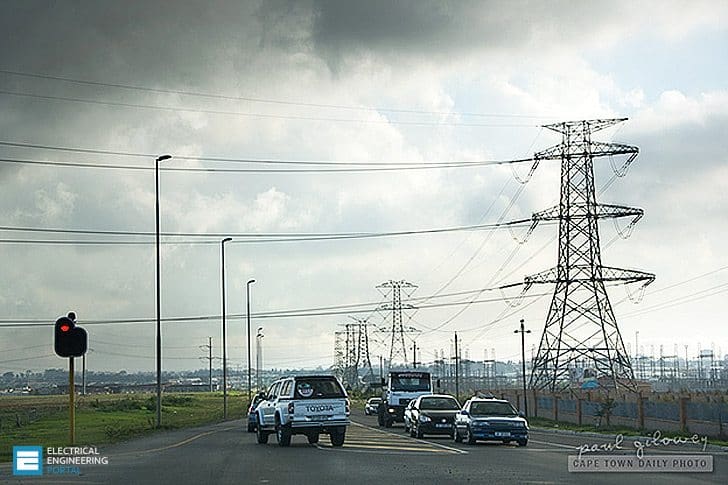
Generation, transmission and distribution
Electricity provision involves three phases: generation, transmission and distribution.
Generation is the process by which electricity is produced; transmission is the transportation of electricity that has been generated in power stations via high voltage, long distance power lines to local networks for distribution; and distribution is the actual delivery of electricity to end consumers.
Electricity generation and transmission together constitute electricity supply and in South Africa this is largely the function of Eskom (in some cases, municipalities have their own generation capacity, but on a very limited scale).
Between 1970 and the early 2000s, South Africa enjoyed a long period of plentiful electricity supply atsome of the lowest prices in the world. This situation changed dramatically in June 2006 as the country’s growing economy began to make full use of the electricity generation capacity that had been built in the 1970s and 1980s.
This led to shortages of electricity and load shedding as the country was not able to generate enough electricity to meet demand, while preventing a collapse of the transmission system.

In response to the shortage of supply, a number of measures were put in place, including immediate efforts to reduce the demand for electricity, and plans to expand generation capacity were fast-tracked.
The global recession that began in 2008, and saw South Africa’s GDP contract by 1.7 per cent in 2009, resulted in reduced demand for electricity, helping to ensure that demand has remained below the available supply and that there has been no load shedding since April 2008. From the supply side, the other critical factor in keeping the lights on during this period has been improved plant reliability achieved by Eskom technicians.
As the South African economy begins to recover (GDP growth is expected to rise to 4.4 per cent by 2013 from the 2.7 per cent estimated for 2010) demand for electricity will also increase, placing strain on the country’s ability to generate enough power to meet demand.
The ability to avoid load shedding over the coming years will depend on both the success of efforts to limit demand through increased energy efficiency and the timing of the completion of new and refurbished electricity generation capacity, and the pace and nature of economic growth.
Increasing generation capacity
Government’s integrated resource plan (IRP) for electricity, approved by Cabinet in March 2011, outlines a strategy for increased generation capacity.
This strategy commits government to completing the programme of constructing new generation capacity that is already being implemented and then provides options for further capacity that will allow the country’s electricity supply to keep pace with the projected future growth in demand.

The current electricity generation build programme added 640 MW to the electricity supply in 2010 and will add another 1 009 MW in 2011.
Although over 70 percent of this capacity will come from coal-fired power stations, the current build programme will go some way towards diversifying the country’s sources of electricity.
This is because almost 90 per cent of current generation comes from coal-fired power stations. Of the committed new capacity, 1 020 MW will come from an independent power producer (IPP) (using an open cycle gas turbine) and a total of 1 125 MW will be added by projects using wind, solar, water and landfills as sources of energy.

The additional generation capacity already committed to, when combined with the impact of demand side management (DSM) measures, will ensure that, from 2013 to 2018, the country will be able to meet the demand for electricity (as well as provide for 15 per cent reserve margin) under all current demand forecasts.
Renewable energy sources make up 47.9 per cent of the new build options.
Generation capacity may be less than peak demand for electricity again in 2011 and 2012, and depending on the pace of growth in consumption could fall below demand again after 2018.
The IRP therefore proposes an ambitious set of options for building additional generation capacity up to 2030 that include:
- an additional 8 400 MW from wind,
- 8 400 MW from photo-voltaic solar generation,
- 1 000 MW from concentrating solar power,
- 2 609 MW from imported hydro sources,
- 6 250 MW from coal, 3 910 MW from open cycle gas turbines,
- 2 370 MW from closed cycle gas turbines and
- up to 9 600 MW from nuclear energy.
After 2018 it is envisaged that renewable energy sources will contribute 47.9 per cent of the new build options, fossil fuels make up 29.5 per cent and nuclear energy accounts for 22.6 per cent.
Government has decided that the IPPs will play a greater role in electricity generation in South Africa in the period ahead. As noted, an IPP is expected to contribute 1 020 MW of generation capacity by the end of 2013. The Department of Energy is also considering several legislative and policy changes to enable IPPs to sell electricity to the national grid.
The declining quality of coal delivered to power stations, the reduced time available for scheduled maintenance due to the low reserve margins and the fact that many aging plants are in need of refurbishment will heighten these risks.
Reference: Local Government Budgets and Expenditure / treasury.gov.za











no need to reply but I just want to say that you are the finest on entire web
I am very happy and honourd to be writting this letter today. I’m studying electrical engineering doing my first year.I would like to have more information about my course , where electricity comes from , I want to have additional information about electricity
First welcome to our EE world!!
Now, EEP is basically divided into Technical articles and Electrical software/Guides. Feel free to explore top navigation menu, I’m sure you will find many interesting stuff.